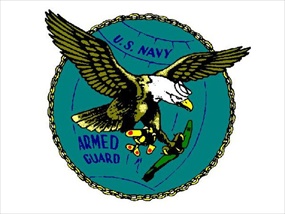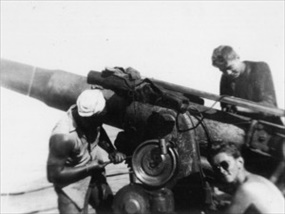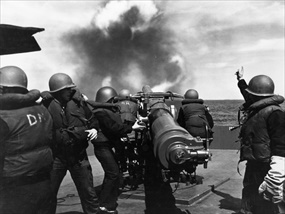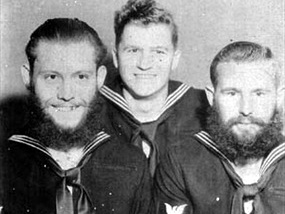U.S. NAVY OPENS ARMED GUARD TRAINING CENTER
Little Creek Naval Training Center, Virginia • September 17, 1941
On this date in 1941 the U.S. Navy created a camp for Armed Guard gun training at Little Creek, Virginia, 12 miles/19 km northeast of the huge naval complex at Norfolk. Few people then and even less now have ever heard of this branch of the U.S. Navy. Often called “the other Navy” or “the forgotten Navy,” the Armed Guard (AG) was established months before the nation was dragged into World War II. Its mission was to train sailors and petty officers to serve aboard variously flagged commercial merchant marine ships during the Battle of the Atlantic (1939–1945). Initially, the Guardmen’s theater of operation was defined by the presence of German U‑boats, surface raiders, and aircraft intent on sinking cargo ships and tankers delivering weaponry, troops, oil, foodstuffs, and other vital goods in support of America’s allies fighting the Axis powers. Armed Guard crews eventually totaled 144,970 personnel, and they served as gunners, signalmen, radio operators, medics, and petty officers on 6,236 ships. In contrast, U.S. Merchant Marines—America’s “fourth arm of defense” after the Army, Navy, and Marines—numbered 250,000 civilians during the war.
Little Creek was the first of 4 basic Armed Guard schools. After the Japanese attack on the U.S. Pacific Fleet at Pearl Harbor on December 7, 1941, 3 other schools opened: one at Gulfport, Mississippi, one at San Diego, California, and a short-lived one in the Chicago area. Largest of the schools, Little Creek’s training practices were adopted by the other schools.
Just as was the case during the First World War, the need for U.S. merchantmen to protect themselves became clearer in the period leading up to Pearl Harbor. A few months into 1941 the U.S. Navy and the U.S. Maritime Commission began discussions on how to arm and man defensive weapons on U.S. non-naval ships then numbering approximately 1,375 (October 1941 figure). Between the 2 world wars merchant ships were essentially unarmed and had no protective armor. The Maritime Commission assumed responsibility for installing defensive items provided by the U.S. Navy on board merchant ships and Navy personnel manned the weapons. Finally, on April 15, 1941, the Armed Guard Service was reactivated, and sailors who had been practicing gunnery at the nation’s naval armories were posted to 1 of the 3 basic Armed Guard schools. All new recruits to the AG were sent there as well. Graduates were assigned to merchant vessels by Armed Guard centers in Brooklyn, New York; New Orleans, Louisiana; and Treasure Island (San Francisco), California.
On December 2, 1941, the first Armed Guard crew of 7 men was placed on board the 3,515‑ton SS Dunboyne crewed by over 30 merchant marines. Steaming as part of convoy PQ 13 with 18 other freighters of mixed registry and 3 British whalers to the Soviet Union’s Arctic port of Murmansk in late March–early April 1942, the Dunboyne fired her 9 guns 58 times, downed 2 enemy planes and possibly a third, and just missed being torpedoed. The Germans sank 5 freighters for a loss of 1 destroyer.
The Dunboyne’s December 1941 departure occurred shortly after the U.S. Congress repealed Section 6 of the Neutrality Act, which prevented arming U.S. merchant ships. Within weeks 55 American-owned ships were assigned Guardsmen. By the end of 1942 Guardsmen were crewed on roughly 1,000 merchant vessels. Assisting the men were civilian mariners who had received elementary gunnery training at U.S. Maritime Service Training Schools.
As war on the high seas tapered off more than 80,000 Armed Guardsmen were integrated into the regular Navy to man guns on, for example, LSTs (Landing Ship, Tank), LCIs (Landing Craft, Infantry), and LCVP (Landing Craft Vehicle, Personnel). These amphibious assault vessels delivered fighting forces, war material, and ancillary personnel directly onto beaches in Africa, Normandy, and the Pacific. Without the courage and sacrifice of Naval Armed Guardsmen, victory over the Axis would have been more difficult and taken longer.
U.S. Navy Armed Guard and U.S. Merchant Marine in World War II
 |  |
Left: U.S. Navy Armed Guard insignia. The Guardsmen’s motto: “We Aim to Deliver.” Many naval personnel were initially despondent upon being assigned to the Armed Guard, believing the Navy had cheated them by denying them a berth in the fleet, giving them instead a 1‑way ticket on a suicide mission in a “slow rust bucket,” that the odds were against them ever returning home, and that they were simply “fish food.” Yes, service in the Armed Guard was fraught with danger, suffering, heroism, and of course casualties. Of the 6,236 ships on which Guardsmen served, 710 were sunk and damaged (less than 1 in 9 vessels under AG protection); 1,810 Armed Guards were killed in action—164 at Leyte in the Philippines campaign alone. Others died from exposure in lifeboats, freezing water, or blistering sun, or suffered unknown injuries (1 in 100). Twenty-seven Guardsmen were taken prisoner, of which 14 survived the war (1 in 2). Contrast that with the merchant seamen with whom the AG mostly served. According to 2 conflicting authorities, 250,000 or 350,000 merchant mariners served during World War II, with over 8,765 men losing their lives. These civilian volunteers died proportionally in numbers that rivaled or exceeded any branch of the U.S. uniformed military. That said, for men in both branches of wartime service, the odds of surviving their duty tours turned out to be pretty good.
![]()
Right: Aboard the oil tanker SS O.M. Bernuth Armed Guards man a 4‑in./101 mm gun. Bernuth’s crew assisted Armed Guardsmen by handing them the heavy shells or firing off 20 mm machine guns. The tramp tanker plied the Gulf of Mexico and possibly the East and West coasts of North America. It survived the war. A mouth-watering AG menu for Thanksgiving dinner 1942 aboard the Bernuth featured grapefruit with maraschino cherry, chicken soup, roast young Vermont turkey, oyster dressing, cranberry sauce or a dinner of baked Virginia ham, cauliflower, asparagus tips, and mashed potatoes. Dessert was pumpkin or mincemeat pie, fruit cake, and mixed nuts, all served with genuine coffee.
 |  |
Left: During gunnery practice at sea in September 1943, Armed Guardsmen learned the finer points of operating this 4‑in./101 mm deck gun aboard a merchant ship. Other calibers were 5‑in./127 mm cannons and 3‑in./76 mm cannons and 20mm (Oerikons) machine guns. Sadly, some shipboard guns dated to the 19th century. From 5‑weeks gunnery training in 1942, recruits received 18 weeks in 1943, with an additional 5 weeks of advanced training at Little Creek. Virtually unknown outside the fleet Navy and sister services, Armed Guardsmen provided a certain measure of defense against enemy sea- and airborne attack, supplementing more aggressive measures provided by escort warships and their crew if the civilian ships formed a convoy. The Armed Guard school at Little Creek (later moved to nearby Camp Shelton) trained over 200,000 Naval personnel and 160,000 Marine Corps and Army personnel.
![]()
Right: Three Naval Armed Guardsmen distinguished by their nonregulation hair and beards pose for a photo while on shore leave. Duty in the AG was acknowledged by sailors as quite hazardous. The average AG detachment numbered 27 men, among them petty officers, a coxswain, gunner’s mates, signalmen, and a radio operator. Naval Guardsmen could find themselves posted to American merchant ships like the tough new 7,176‑ton Liberty or the faster Victory ship, as well as to those of Allies or occupied nations such as Denmark, Norway, and France, which were a hodgepodge. Enemy submarines and aircraft posed constant threats, but so too did climate, weather, and tempestuous seas churned by tropical storms or Arctic gales. During dangerous subzero winter convoys to Arctic ports in the Soviet Union men stationed at deck guns wore heavy gloves, alpaca fleece-lined hats, face masks, fur-lined goggles, heavy fur-lined trousers, wool pants, and thermal underwear; jackets and sweaters were worn beneath parkas.
“One Sailor’s Story”: Well-Done Digital Photo Album of Grandfather’s World War II Service in U.S. Navy Armed Guard
![]()

 History buffs, there is good news! The Daily Chronicles of World War II is now available as an ebook for $4.99 on Amazon.com. Containing a year’s worth of dated entries from this website, the ebook brings the story of this tumultuous era to life in a compelling, authoritative, and succinct manner. Featuring inventive navigation aids, the ebook enables readers to instantly move forward or backward by month and date to different dated entries. Simple and elegant! Click
History buffs, there is good news! The Daily Chronicles of World War II is now available as an ebook for $4.99 on Amazon.com. Containing a year’s worth of dated entries from this website, the ebook brings the story of this tumultuous era to life in a compelling, authoritative, and succinct manner. Featuring inventive navigation aids, the ebook enables readers to instantly move forward or backward by month and date to different dated entries. Simple and elegant! Click 











